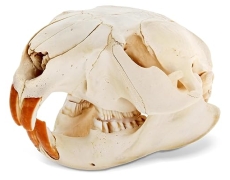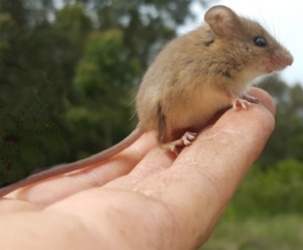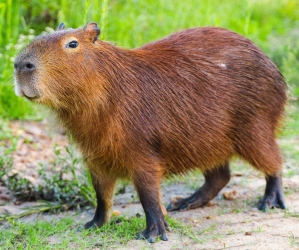 A rodent is a gnawing mammal in the order Rodentia that includes rats, mice, squirrels, chipmunks, hamsters and porcupines, as well as the largest North American rodent, 
All rodents possess constantly growing rootless incisors that have a hard enamel layer on the front of each tooth and softer dentine behind. The differential wear from gnawing creates perpetually sharp chisel edges. Powerful muscles attached to jaw and skull provide most of the power for chewing and gnawing. The range in body sizes of rodents is remarkable. One of the smallest is Delany’s swamp mouse living in the marshes and mountain forests of Africa. It weighs a tiny 5 to 7 grams, and its body is only 5 cm long. The largest rodent is the capybara of Central and South America, which weighs up to 66 kg and stands 60 cm at the shoulder, with a body over a metre long.   Delany's mouse (left) and a South American capybara (right) Incidentally, you might think that shrews are tinier than the Delany's mouse above. While that's true, shrews are not rodents, but insectivores. Rodents may be diurnal or nocturnal, or sometimes active part of the day and the night. Although some species are herbivorous, diets of most include vegetable and animal matter. Others are opportunistic omnivores, and some are specialized carnivorous predators, like the grasshopper mouse. Some species living in arid habitats and on oceanic islands are able to obtain their water requirements from their food. Rodents may be active all year, or enter periods of dormancy or deep hibernation. Breeding frequency, the length of gestation, and litter sizes vary widely. Two of the most prolific rodents are both associated with humans. The brown rat can give birth to litters of up to 22 offspring, and the house mouse can produce up to 14 litters annually. The impact of the many rodent species on human populations ranges from inconvenient to deadly. Crops are damaged before harvest, and stored food is contaminated by rodent waste. Water-holding structures leak from burrowing, and objects are damaged by gnawing. Certain species of rodent are reservoirs for diseases such as plague, typhus, tularemia, rat-bite fever, Rocky Mountain spotted fever, and Lassa fever, among others. While only a few species, such as the house mouse and rat, are serious pests or vectors of disease, it is these rodents that have always been most closely associated with people. Some rodents are in fact beneficial, providing a source of food (capybaras, woodchucks), clothing made from their fur (nutria, chinchilla), as well as test animals for biomedical and genetic research (specially bred mice and rats). Some rodents provide pleasure as household pets (hamsters, guinea pigs, and gerbils). |